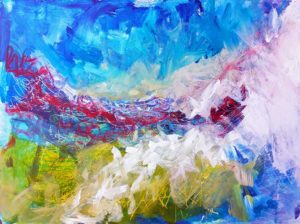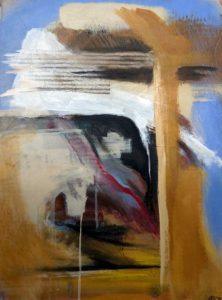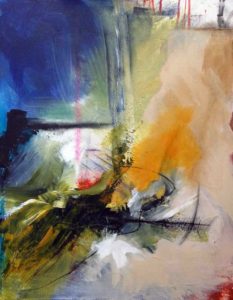I wrestle with geometry all the time. Horizontal, vertical and diagonal. Circle, square, triangle. On and On and On.
 If I am painting intuitively, without intention, what is that sharp, flat, horizontal line doing on my canvas? Put a horizontal line or field on my canvas and I will show you a landscape. That’s what the brain does when it perceives a horizontal line: it makes a landscape. Show me a circle on a canvas and I’ll show you a face, because that’s what the mind does: it makes a face.
If I am painting intuitively, without intention, what is that sharp, flat, horizontal line doing on my canvas? Put a horizontal line or field on my canvas and I will show you a landscape. That’s what the brain does when it perceives a horizontal line: it makes a landscape. Show me a circle on a canvas and I’ll show you a face, because that’s what the mind does: it makes a face.
The face is not the circle, and the horizon is not the line, but these things are code that is universally recognized. Even in the most abstract pieces, when we see a circle, we try to make a face. The flat line is code for landscape and we work hard to make one. It’s ok. I think all artists want viewers to participate in the creative process, to have them make of the work what they will. But if I am truly in the moment of painting, without thought or intention, how is it that I keep coming up with this . . . code?
I look at abstract art all the time. Some of it is famous – you’d know it. Most of it is not.  Most of it is people, just like me, having an experience and then sharing the result. I am often surprised at how geometry creeps in to even the most abstract pieces. There is this cross thing that shows up over and over. Rarely is it focused on the center of the canvas, like a Christian cross; instead, it is off to the side or down low. It may not even be that obvious, but it divides the canvas up into areas that aid the viewer in seeing the piece. Often, horizontal, vertical and diagonal work together to establish walls, floors and depth. In the best of cases this just happens; but sometimes it is contrived.
Most of it is people, just like me, having an experience and then sharing the result. I am often surprised at how geometry creeps in to even the most abstract pieces. There is this cross thing that shows up over and over. Rarely is it focused on the center of the canvas, like a Christian cross; instead, it is off to the side or down low. It may not even be that obvious, but it divides the canvas up into areas that aid the viewer in seeing the piece. Often, horizontal, vertical and diagonal work together to establish walls, floors and depth. In the best of cases this just happens; but sometimes it is contrived.
I know this: I always listen to music when I paint. I can let my conscious mind lose itself in the music, freeing the unconscious me to dance with the canvas. But music is mathematical!  For me it’s all about horizontal – which, in music, is time: 1 and 2 and 3 and 4; and it’s all about vertical, which is pitch: C-D-E-F-G-A-B-C. The diagonal connects the dots leading the listener through time and over the rising and falling pitch that makes melody.
For me it’s all about horizontal – which, in music, is time: 1 and 2 and 3 and 4; and it’s all about vertical, which is pitch: C-D-E-F-G-A-B-C. The diagonal connects the dots leading the listener through time and over the rising and falling pitch that makes melody.  With all of this musical geometry going on in my conscious mind is it any wonder some of it creeps into the canvas?
With all of this musical geometry going on in my conscious mind is it any wonder some of it creeps into the canvas?
I think, most times, abstract art needs a subtle skeleton on which to hang itself. Lines and fields of color and depth and composition often benefit from a scaffold and a structure, however subtle. My commitment is to let those subtle structures reveal themselves without manipulative intervention from me!